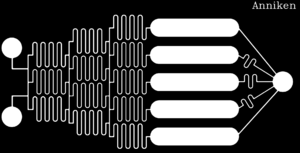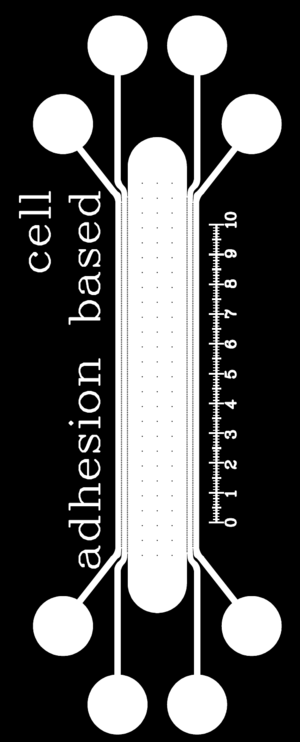Difference between revisions of "Kick-off meeting spring semester 2022"
Dagkd@uio.no (talk | contribs) |
Dagkd@uio.no (talk | contribs) |
||
| Line 46: | Line 46: | ||
Papers on microfluidic systems with gas control for cell culture: | Papers on microfluidic systems with gas control for cell culture: | ||
* [https://iopscience.iop.org/article/10.1088/1361-6439/aaa993 Wu (2018), review paper] | * [https://iopscience.iop.org/article/10.1088/1361-6439/aaa993 Wu (2018), review paper] | ||
| + | * [https://www.elveflow.com/microfluidic-reviews/microfluidics-for-cell-biology/ph-monitoring-in-microfluidics-a-short-review/ Elveflow: pH monitoring in microfluidics] | ||
* [https://www.mdpi.com/1424-8220/17/7/1603 Bunge (2017)] | * [https://www.mdpi.com/1424-8220/17/7/1603 Bunge (2017)] | ||
* [https://pubs.rsc.org/en/content/articlelanding/2013/lc/c3lc50643f Giulitti (2013)] | * [https://pubs.rsc.org/en/content/articlelanding/2013/lc/c3lc50643f Giulitti (2013)] | ||
| Line 52: | Line 53: | ||
These protocols should be tested with and without cells. | These protocols should be tested with and without cells. | ||
==== Bubble-free operation ==== | ==== Bubble-free operation ==== | ||
| + | Here are a series of nice and practical introductions from Elveflow with lots of tips: | ||
| + | * [https://www.elveflow.com/microfluidic-reviews/microfluidics-for-cell-biology/methods-and-techniques-perfusion-cell-culture/ Techniques for perfusion (flow through) cell culture] | ||
| + | * [https://www.elveflow.com/microfluidic-reviews/microfluidics-for-cell-biology/ Lots of different small articles.] | ||
==== Defining safe flow levels for cells ==== | ==== Defining safe flow levels for cells ==== | ||
| + | How fast can the flow be without killing the cells on the way? Do tests with flow measurement. Question: how to evaluate success? | ||
==== Switching of different fluids ==== | ==== Switching of different fluids ==== | ||
| + | Train on using manifolds and MUX | ||
==== Gel barrier filling ==== | ==== Gel barrier filling ==== | ||
| + | Pressure or suction? How long time after cell assembly to have the right hydrophobicity? | ||
[[File:Anniken network.png|left|thumb|Network with gradient generator]] | [[File:Anniken network.png|left|thumb|Network with gradient generator]] | ||
[[File:Gel gas flow network.png|left|thumb|Network with gas flow channels separated from cell area with gel channels.]] | [[File:Gel gas flow network.png|left|thumb|Network with gas flow channels separated from cell area with gel channels.]] | ||
Latest revision as of 17:23, 27 January 2022
Present: Kristina, Erik, Claudia, Tiril, Thomas and Dag
Contents
Plan for spring 2022
Current state of project
- We have some microfluidic chip designs we can use although none are perfect (see examples below)
- Protocol for fibronectin coating is established
- Filling with cells works and cells do adhere.
- Problems with air bubbles.
- Finite lifetime of cells. Probably because they lack oxygen and correct CO2 level.
Goal for semester
Make a device that fulfills the following
- Controls CO2 level
- CO2 input can be quickly changed
- CO2 concentration is measured
- feedback from measurement to CO2 input
- Cells adhere
- Cells stay alive and divide until they are confluent
- Splitting: partial cell release by trypsination and increased flow rate
- Cells continue to adhere and divide after splitting
- Possibly perform an additional experimentlike
- migration assay by entering SDF-1/CXCL12 into a side channel
- Ca2+ activation by flow, PBS and other changes
Write a scientific paper. Possible journals:
- Micromachines (MDPI)
- Sensors (MDPI)
- Frontiers in Bioengineering and Biotechnology
- Biomicrofluidics
- Microfluidics and Nanofluidics
Specific sub-projects
CO2 measurement
In order to integrate a reliable CO2-measurement without too much development we will use the Zimmer & Peacock ISE OEM, pH sensor and software. The first challenge will be to integrate the sensor into the medium flow, either on the chip or connecting with a tube.
CO2 input change
Choice of method Some background discussion is found here.
- Control of CO2 in media source. This can only give slow changes of CO2 concentration
- Control of CO2 in side channel. This can yield quick CO2 changes. The side flow channel can be either
- wet gas from gas blender
- CO2-saturated media or CO2-concentration regulated media (no need for expensive gas blender, but extra flow control needed)
- Choose membrane to side channel
- PDMS: simpler to avoid gel filling step, but permeability is probably lower.
- Gel: High permeability, more complex fabrication.
Papers on microfluidic systems with gas control for cell culture:
- Wu (2018), review paper
- Elveflow: pH monitoring in microfluidics
- Bunge (2017)
- Giulitti (2013)
- Forry (2011)
Robust microfluidic protocols
These protocols should be tested with and without cells.
Bubble-free operation
Here are a series of nice and practical introductions from Elveflow with lots of tips:
Defining safe flow levels for cells
How fast can the flow be without killing the cells on the way? Do tests with flow measurement. Question: how to evaluate success?
Switching of different fluids
Train on using manifolds and MUX
Gel barrier filling
Pressure or suction? How long time after cell assembly to have the right hydrophobicity?

